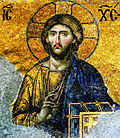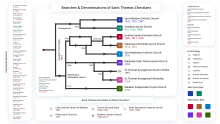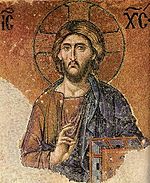مسیحیت سریانی
| بخشی از مجموعههای |
| مسیحیت شرقی |
|---|
 |
مسیحیت سریانی (به سریانی: ܡܫܝܚܝܘܬܐ ܣܘܪܝܝܬܐ) یکی از گونههای مسیحیت شرقی است که الهیات و مناسک مذهبی را به زبان سریانی بیان میکنند.[۱][۲][۳] این زبان در کنار زبانهای لاتین و یونانی یکی از سه زبان مهم مسیحیان در دوران مشترک بود.[۴]
مسیحیت سریانی شامل دو گروه با آداب مذهبی متفاوت است. آداب سریانی شرقی (به کلدانی، آشوری و ایرانی هم معروف است[۵]) که کلیساهای کاتولیک کلدانی، آشوری شرق و باستانی مشرق را در عراق و کلیساهای کاتولیک سریانی مالابار و سریانی کلدانی را در هند در بر میگیرد و آداب سریانی غربی که کلیسای ارتدکس سریانی در سوریه، کلیساهای مارونی و سریانی کاتولیک در لبنان و شش شاخه دیگر در هند را در بر میگیرد که دوتای آنها پروتستان هستند.[۶][۷][۸] در هند به مسیحیان هر دو شاخه مسیحیان سریانی یا مسیحیان سنت توماس گفته میشود.[۹]
زبان سریانی گونهای از زبان آرامی میانه است که در ادسا در جزیره در قرن اول میلادی پدیدار شد[۱۰] و بسیار نزدیک به زبان آرامی عیسی است.[۱۱] این نزدیکی به اعتبار آن برای مسیحیان بسیار افزودهاست.[۱۲] شکل زبان مورد استفاده در ادسا بر نوشتههای مسیحی غالب بود و به عنوان گونه استاندارد پذیرفته شده برای گسترش مسیحیت هرجایی که بستر زبان آرامی بود شناخته میشد.[۱] منطقهای که در آن سریانی یا آرامی سخن گفته میشد منطقه تماس و درگیری امپراتوری روم و شاهنشاهی ساسانی بود و کل یا بخشهایی از لبنان، فلسطین، سوریه، ترکیه، عراق و ایران را در بر میگرفت.[۲]
کلیساهای مسیحیت سریانی[ویرایش]
جستارهای وابسته[ویرایش]
- کلیسای آشوری مشرق
- کلیسای ارتدکس سریانی
- کلیسای سریانی کاتولیک
- کلیسای کاتولیک کلدانی
- کلیسای باستانی مشرق
پیوند به بیرون[ویرایش]
منابع[ویرایش]
- ↑ ۱٫۰ ۱٫۱ Lucas van Rompay, "The East: Syria and Mesopotamia" in Susan Ashbrook Harvey, David G. Hunter (editors), The Oxford Handbook of Early Christian Studies (Oxford University Press 2008), p. 366
- ↑ ۲٫۰ ۲٫۱ Heleen Murre-van der Berg, "Syriac Christianity" in Ken Parry (editor), The Blackwell Companion to Eastern Christianity (John Wiley & Sons 2010), p. 249
- ↑ Robert A. Kitchen, "The Syriac Tradition" in Augustine Casiday, The Orthodox Christian World (Routledge 2012), p. 66
- ↑ Wilken, Robert Louis (2012-11-27). The First Thousand Years: A Global History of Christianity. New Haven and London: Yale University Press. p. 26. ISBN 978-0-300-11884-1.
- ↑ John Hardon (25 June 2013). Catholic Dictionary: An Abridged and Updated Edition of Modern Catholic Dictionary. Crown Publishing Group. p. 493. ISBN 978-0-307-88635-4.
- ↑ Pallikunnil, Jameson K. (2017). The Eucharistic Liturgy: A Liturgical Foundation for Mission in the Malankara Mar Thoma Syrian Church (به انگلیسی). ISBN 978-1-5246-7652-0.
Metropolitan Juhanon Mar Thoma called it “a Protestant Church in an oriental garb”. As a reformed Oriental Church, it agrees with the reformed doctrines of the Western churches. Therefore, there is much in common in faith and doctrine between the MTC and the reformed Churches of the West. As the Church now sees it, just as the Anglican church is a Western Reformed Church, the MTC is an Eastern Reformed Church..
- ↑ World Council of Churches, "Mar Thoma Syrian Church of Malabar"
- ↑ Ed Hindson, Dan Mitchell (editors), The Popular Encyclopedia of Church History (Harvest House Publishers, 2013), p. 225
- ↑ Abraham Vazhayil Thomas, Christians in Secular India (Fairleigh Dickinson Univ Press, 1974), p. 90
- ↑ Cameron, Averil; Garnsey, Peter (1998). The Cambridge Ancient History. Vol. 13. p. 708. ISBN 978-0-521-30200-5.
- ↑ Allen C. Myers, ed (1987). "Aramaic". The Eerdmans Bible Dictionary. Grand Rapids, Michigan: William B. Eerdmans. p. 72. شابک ۰−۸۰۲۸−۲۴۰۲−۱. "It is generally agreed that Aramaic was the common language of Palestine in the first century A.D. Jesus and his disciples spoke the Galilean dialect, which was distinguished from that of Jerusalem (Matt. 26:73)."
- ↑ Robert L. Montgomery, The Lopsided Spread of Christianity: Toward an Understanding of the Diffusion of Religions (Greenwood Publishing Group 2002), p. 27
- مشارکتکنندگان ویکیپدیا. «Chaldean Syrian Church». در دانشنامهٔ ویکیپدیای انگلیسی، بازبینیشده در ۷ ژوئن ۲۰۲۰.




